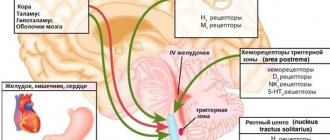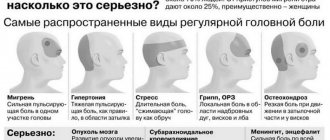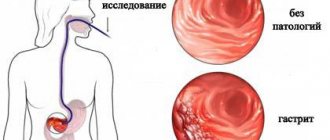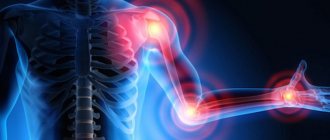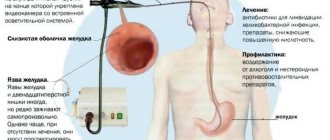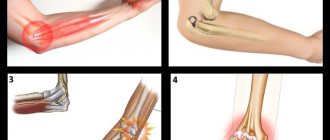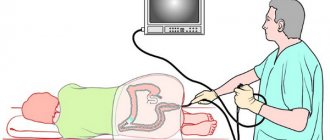The most common causes of headache, nausea and vomiting
What can trigger the development of a pathological condition? Often the causes of headache attacks with nausea and vomiting are the following problems:
- increased intracranial pressure;
- osteochondrosis of the cervical spine;
- the presence of tumors in the brain;
- injuries to the skull and neck;
- allergic reactions, visual impairment, ARVI;
- infection of the frontal and nasal cavities - sinusitis, pharyngitis;
- inflammation of the membranes and tissues of the brain - encephalitis, meningitis;
- hormonal abnormalities;
- migraine;
- ischemic disease;
- stroke;
- severe overstrain of the shoulder muscles.
And believe me, this list is not exhaustive. Only a specialist using specific equipment can detect the specific cause of an anomaly.
You should not determine your diagnosis yourself. After all, further treatment depends entirely on the initial causes of the problem. But what to do if there is no way to see a doctor, and the condition requires immediate intervention? In this case, of course, you need to make every effort to alleviate your condition as much as possible. But to do this, you need to understand the problem in more detail and try to understand what exactly triggered its appearance.
Arterial hypertension
Despite the fact that various factors can provoke the development of arterial hypertension (high blood pressure), the symptoms of the pathology in each case will be approximately the same. The human body, which is susceptible to this disease, will react with increased pressure to overwork, stressful situations, and weather changes.
In such cases, patients experience vasospasm, which causes paroxysmal headaches, which are also accompanied by redness of the facial skin and severe nausea. In severe cases, patients also experience swelling in the legs and increased heart rate.
With arterial hypertension, it is extremely important to understand in time what led to the deterioration of a person’s condition and take all measures to get rid of the provoking factor. In case of a serious condition, you need to quickly start treatment, because there is a possibility of developing a hypertensive crisis or stroke (it is necessary to treat in medical institutions, and not at home using folk remedies).
Intoxication
Poisoning is caused by toxins that appear in excess in the body. The blood carried the substances to the organs. The listed symptoms include diarrhea, vomiting and specific symptoms caused by a specific type of toxin. Nausea occurs as a protective reaction of the body. Leads to vomiting. The patient feels the change in condition immediately.
Preventing nausea is not recommended. This means reducing the level of toxins in the body. Body temperature rises to 39 degrees. Constant headache getting worse. Unpleasant feeling in the stomach. Poisoning with drugs can result in death.
https://youtu.be/IOifMaJmGfE
Nausea after eating in women, causes
If nausea occurs after eating, this indicates diseases or malfunctions of the digestive system. This symptom can hide both harmless overeating and a serious illness that carries risks to life.
Nausea after eating indicates problems with the digestive system.
By the nature of the symptoms accompanying nausea, you can determine which organ is giving a signal about a problem. So, if pain begins while eating food, it can be assumed that there are diseases of the liver and gall bladder. They are accompanied by pain in the right side of the abdomen, under the ribs and a feeling of bitterness in the mouth.
If a pancreatic disease such as pancreatitis develops, then after a meal you will experience not only nausea, but also girdle pain. Both before and after eating, nausea occurs with hypothyroidism, when a significant decrease in appetite is felt, with active weight gain and frequent chills.
Nausea, loss of appetite, chills - symptoms of hypothyroidism
Nausea that occurs some time after eating food may indicate an intestinal infection. In this case, abdominal pain, loose stools, fever, and even possible vomiting will occur. Against this background, other symptoms of intoxication arise.
Nausea can lead to vomiting
Nausea can also occur for more harmless reasons:
- binge eating
- eating food that tastes and smells unpleasant
- toxicosis during pregnancy (usually during and after breakfast)
- psychological disorders
- use of certain drugs
- vigorous physical activity after a heavy meal
Nausea and dizziness with low blood pressure
Damage to blood vessels often leads to such a disorder. It is because of this that many people experience unpleasant symptoms such as dizziness, pain, weakness and even loss of consciousness.
The most common pathology with such a clinical picture is migraine. Although these are not its main signs. Much more often it is detected due to pulsating attacks, which become more frequent with age.
In addition, this disorder is characteristic of prolonged abstinence from food. This is explained simply: the required volume of blood and nutrients does not enter the vessels.
Typically, this condition is encountered by people suffering from high or low blood pressure. The pathology resembles drowsiness and severe fatigue. The pain is most often localized in the forehead area. If this symptom is accompanied by deterioration of vision, then the reason lies in the extra pounds.
Often dizziness, pain and fainting with nausea plague people after some kind of injury, a little less often - due to cerebral edema. True, in the latter case, patients also experience a kind of clumsiness. If he loses consciousness, then after recovering from fainting, vomiting and nausea occur.
In addition, a person experiences a loss of strength, spots appearing before the eyes, and cold hands and feet. He may complain that his head feels like a tight bandage is squeezing him. Among other things, the patient's hearing may deteriorate. With varying degrees of swelling or injury, a person may even stop coping with basic tasks.
To get rid of unpleasant symptoms forever, you need to fight the disease that provokes them. Otherwise, the attacks will repeat again and again. If you fight the consequences of pathology, the effect will be temporary.
The easiest way to deal with nausea is to induce vomiting. This can be done by drinking a large amount of water (to be sure, it needs to be “tinted” a little with manganese) or by pressing with your fingers or an oblong object on the base of the tongue. After this, it is advisable not to eat for at least an hour; only clean, non-carbonated water is allowed.
If nausea is caused by poisoning, you can resort to the help of pharmaceuticals. Suitable:
- Motilium;
- Splenin;
- Cerucal;
- Sorbex;
- Activated carbon.
The dosage is calculated individually; you can refer to the instructions.
Not everyone can endure a severe headache for a long time, and it is better to do so. Even if the exact reasons have not yet been established, it is worth resorting to the use of painkillers: Citramon, Nurofen, Ketorol, Tempalgin or Spazgol.
Also, if possible, you need to create the most comfortable and convenient conditions for yourself: provide access to fresh air, peace and quiet.
Low blood pressure, hypotension may be a consequence of weak tone of the walls of blood vessels. The physiological and pathological process is considered. To determine the true nature of the origin of the disease, it is recommended to do a full examination. The main manifestation of hypotension is a feeling of nausea with dizziness.
Dizziness with nausea manifests itself as a result of vegetative-vascular dystonia, which is a symptomatology that determines a functional malfunction in the performance of human organs with impaired innervation. VSD is the primary cause of low arterial readings, occurring:
- In young age;
- With a hereditary factor;
- Hormonal disorders;
- Stressful situations;
- Severe fear;
- Bleeding;
- Due to a complication of a previous illness.
At a low value, dizziness and nausea are caused by severe fatigue, constant stressful situations, and nervous tension. The symptom occurs due to:
- Osteochondrosis;
- Diabetes mellitus;
- Anaphylactic shock;
- Hyperthyroidism;
- Neuropathies;
- Arrhythmias.
Nausea and dizziness are accompanied by poor health, migraines, visual disturbances, and loss of control over coordination.
If the level is low, it is recommended to seek medical help. The measure taken preserves good health and life expectancy.
It is not recommended to use sedatives and sedatives that help reduce blood pressure. Even if an increase in emotional state is considered, as with normal blood pressure. The patient is offered a strong caffeine-containing drink, the drug Citramon. Subsequently, it is recommended to visit your doctor for diagnosis and prescribing appropriate treatment.
Treatment of hypotension and symptoms are related to the specific disease. Treatment includes a balanced diet, outdoor walking, and moderate physical activity. The patient must be determined to comply with the norms and therapeutic rules. Physical activity increases vascular tone, which has a beneficial effect on arterial parameters.
It's better to exercise instead of regretting lost time. The patient is not recommended to wake up abruptly in the morning. It is recommended to include one mug of coffee and strong black tea in breakfast. The measures prevent the occurrence of diseases of the cardiovascular and other body systems.
Regular or periodic headaches (cephalalgia) with nausea are a sign of a pathological condition or severe fatigue. Similar symptoms often accompany migraines, concussions, surges in blood pressure, colds, and changes in blood vessels. If you often have a headache and feel nauseous, look for the true cause of the ailment, and do not fight its manifestation.
You need to fight the disease, not its symptoms; frequent pain is a signal to consult a doctor
Types of pain
Severe headaches and nausea if the body’s functioning is disrupted.
To determine the cause, there are 4 types of pain with nausea and vomiting:
- dull pain and mild nausea;
- acute sharp pain with throbbing and nausea;
- sharp pain accompanied by vomiting;
- dull pain with incessant vomiting.
Mild dizziness and mild nausea without vomiting are typical for overwork and low blood pressure. During this period, doctors recommend refraining from food and sudden movements. Sharp and throbbing headaches, accompanied by vomiting, occur with injuries, strokes, a sharp increase in intracranial pressure and inflammatory diseases.
Continuous vomiting with dull and paroxysmal pain is characteristic of a stroke or severe fatigue. She requires immediate medical attention.
Therapy with folk remedies
If there is no trust in pharmaceutical drugs or there is no opportunity to take medicine, you can use traditional medicine recipes. So, warm sweet teas with the addition of lemon and mint help soothe headaches. There are other methods that are effective for frequent, prolonged attacks:
- decoction of rowan bark;
- corn oil;
- a mixture of raisins, walnuts and tangerines;
- chamomile tea;
- a decoction of Ivan tea, oregano and mint.
Ginger root, rich in essential oils, helps relieve nausea. It can be used by anyone: ginger candies, pickled “petals” and just a small piece of pulp will do. The root is prohibited only for people taking anticoagulants or aspirin. You can replace it with sour citrus fruits - lemon or orange.
Non-drug methods to relieve symptoms
There are many non-drug remedies that can help relieve headaches and nausea, depending on the cause.
Describe your problem to us, or share your life experience in treating the disease, or ask for advice! Tell us about yourself right here on the site. Your problem will not go unnoticed, and your experience will help someone! Write >>
Quick remedies to eliminate unpleasant symptoms are:
- warm tea with mint and lemon;
- cool water compress with the addition of essential oils of lemon, grapefruit or lemon balm;
- eating fresh citrus fruits (orange or lemon slice) for nausea;
- clay compress with menthol oil;
- a decoction of mint, fireweed and oregano.
Feel free to ask your questions right here on the website. Write >>
To prevent headaches along with nausea, use safe non-medicinal agents with cumulative action:
- Corn oil for migraines, which must be consumed for 14 days in 2 tbsp portions. In the first days, the dose is taken 1 time per day, after which it is gradually increased to 3 times.
- Raisins, tangerines and walnuts. Half an hour before breakfast, you should alternately eat a tangerine, a dozen raisins and the kernels of 3 walnuts for 3 months, without mixing the ingredients, and after half an hour, wash everything down with a glass of water.
- A decoction of rowan bark, which should be drunk in three doses per day for up to 30 days. To do this, 400 g of bark is boiled for at least 2 hours and, when cooled, consumed in a tablespoon.
Cerebral blood flow disorders
Blood pressure increases. A high value becomes dangerous. Narrowing of the lumen of blood vessels acts as a cause of weakness. Feels dizzy. Nausea worsens. The brain does not receive enough oxygen. There is noise in the ears, mental activity and concentration decrease.
They may be harbingers of severe brain diseases of infectious etymology. Concussion and traumatic brain injury are characterized by a weak state and nausea. Brain tumors provoke severe pain in the head and changes in body temperature. During a stroke, speech is affected and movements are uncoordinated. It is not recommended to relieve pain on your own. The doctor must examine and prescribe treatment.
Weakness and chills
Severe headache, nausea, and vomiting may indicate the development of meningitis, infection of the tissues surrounding the spinal cord or brain. At the same time, a person’s temperature rises, which actually causes weakness. Chills gradually develop.
Adult patients suffer from such symptoms when the blood vessels in the head become inflamed. In this case, the person feels as if excessive pressure is being applied to the affected areas.
Often, headache, nausea, vomiting and weakness coincide with some kind of injury, or are its consequences. Usually, in this case, a person’s metabolism suddenly deteriorates, and he is faced with the following manifestations:
- tingling in the extremities;
- complete numbness of the arms and legs;
- a feeling of severe heaviness in the back of the head.
Often, a combination of symptoms such as weakness, headache, vomiting and nausea is provoked by hemorrhage inside the skull, stroke, or subdural hematoma. If the cause of the condition lies in frontal sinusitis, pain from the forehead area radiates to the back of the head and temples. The pathology is accompanied by severe muscle weakness. Sometimes people with these symptoms are diagnosed with giant cell arteritis.
In addition, such signs can occur in children and adolescents during their growing years. Although in the vast majority of cases, headaches in combination with nausea, vomiting and weakness in young patients appear for the same reasons as in adults. All sorts of complications can be detected using ordinary tests.
Additional symptoms
Symptoms accompanying nausea and headache allow specialists to determine the cause of alarming symptoms. In some cases, the nature of the pain, as well as its location, can indicate a disease or disorder. There are no pain receptors in the nervous tissue of the brain; other areas of the neck and head can hurt:
- subcutaneous tissue;
- eyes;
- periosteum;
- sinuses;
- veins;
- nerve endings;
- arteries;
- muscles;
- mucous
With pain in the neck and spine, displacement of the intervertebral joints of the cervical spine can be suspected. People who spend most of the day in a sitting position and do not move enough are at risk. Nausea not associated with eating, occasional headaches, and intolerance to loud noises and bright lights may indicate both a concussion and brain tumors.
Pain and nausea may also be accompanied by the following symptoms:
- chills;
- tides;
- high blood pressure;
- high temperature;
- loss of orientation;
- deterioration of vision and hearing.
Any of these signs of pathology has important diagnostic value. Regular headaches are a reason to consult a doctor, and you should not postpone the examination.
Reviews
Viktor Mikhailovsky, 45 years old:
After a trip to the sea, my neck hurts very much. At first I thought there was a blow somewhere or a pinched nerve. On the second day, the pain began to intensify, especially in the evening and at night. When I yawn, I feel a terrible strain in my neck, I can’t eat normally, or even get out of bed.
Today, not knowing what to do, I went to the doctor. After examination and photographs, a conclusion was made - osteochondrosis of the cervical spine. The doctor said what you can take, what pills and medications help alleviate the disease. I have been undergoing treatment for a week now - the tension in the neck area has subsided, yawning is not painful, only a runny nose and headaches remain.
Diana Goncharova, 30 years old:
I constantly watch Malysheva’s TV shows, so when my nose started to get stuffy, I started feeling feverish and even had pain in my ear – I immediately realized that I had a cold. I decided to take painkillers and anti-inflammatory drugs.
The next day, I had just woken up when I began to sway, felt heavy in my legs, felt nauseous and was very hot. The pulse was frantic, and the pressure was 140/77. I didn’t know how to get rid of this condition or what to drink, so I immediately called a doctor.
Headache and fever
Flu and ARVI are diseases that provoke the development of various symptoms. When the temperature rises, suspicion most often falls on them. Against the background of infection, intoxication of the entire body occurs. The temperature during ARVI and influenza is usually stable and fluctuates between 37.5-37.8 degrees. If a person has a headache and fever, they most likely have an infectious disease.
But with meningitis, the patient experiences a very severe headache, vomiting and nausea. The condition is complemented by other symptoms. The occipital muscles are very tense. If a person experiences this condition, a team of doctors should be called immediately.
With the flu, the headache is less severe. It affects the temples, eyes and forehead.
This disease can be easily distinguished by specific symptoms: pain, fever and muscle weakness.
If the nervous system is experiencing a more serious pathology, other symptoms will tell you about it: headache, nausea and vomiting. If such manifestations occur, do not delay going to the doctor.
Causes of nausea in an elderly woman
A feeling of nausea in an older woman, accompanied by other symptoms, can occur for a variety of reasons. As a rule, at this age the body is susceptible to a large number of diseases, among which the most common are diseases of the digestive organs, heart, and neurological disorders.
Nausea in older people occurs for many reasons
Nausea in older women can occur due to severe pancreatitis, intoxication, diabetes, cancer, stroke, or due to minor malfunctions in the functioning of internal organs or poor diet and daily routine.
The causes of headaches and nausea in older women can be associated with various diseases, therefore, it is also important to consider the presence of additional symptoms. In particular, it may be associated with diseases of the digestive, cardiovascular system and neurological disorders.
Nausea and headaches in older women can occur with diabetes, pancreatitis, stroke, cancer, as well as minor disorders of the functioning of internal organs.
Causes of pain in the morning
Pathology can be diagnosed based on specific signs. Attacks of headaches with nausea are quite common. Even individual manifestations of this condition occur in various diseases. A survey alone is not enough to determine the causes of headaches, nausea and vomiting. A thorough examination is necessary. But it is necessary to know the probable causes of frequent pain and nausea.
There are several common reasons:
- Brain defects. This group includes chronic and acute injuries, meningitis, benign and malignant neoplasms. Approximately 8-10% of all patients complaining of headaches and nausea are faced with such diagnoses.
- Psychogenic pathologies. Often they are the causes of headaches in the morning after a full night's sleep. Typically, this condition is provoked by lack of sleep, stress, prolonged concentration and other stress. In this case, the pain is mild or moderate in nature, but has no clear localization.
- Headaches can occur due to vascular damage. This category includes migraine attacks and arterial hypertension.
- Internal reasons. Pain that occurs against the background of pathologies of internal organs resembles symptoms of intracranial pressure. Patients complain of unbearable sensations literally bulging from the inside of the brain. Sudden loss of consciousness is possible.
- Reasons not related to brain activity. This group includes viral and infectious diseases, side effects from taking alcoholic beverages and medications, metabolic disorders, abnormalities in the skull, eyes, neck, including osteochondrosis. It is infections that cause headaches along with nausea and vomiting in approximately 40% of all patients.
Causes of nausea in women during menopause
Sooner or later, a woman ages, and a sign of this is the transition of her body to the menopause phase. Often this condition is accompanied by nausea, since during this period the main female hormone estrogen is produced in small quantities. And changes in hormonal levels are perceived by the female body as a stressful situation, which makes itself felt by the occurrence of specific reactions.
Nausea and headache are quite unpleasant symptoms, so it is important to carry out timely therapy to eliminate the discomfort.
Unfortunately, sooner or later a woman ages, and menopause is considered one of the signs of this process entering the active phase. Most young women fear it like fire, while others accept it with resignation, but one of the symptoms of menopause - nausea - remains unacceptable and unpleasant for everyone.
Nausea during menopause
The main female hormone, called estrogen, begins to be produced in reduced quantities during menopause. In this regard, changes occur in the body as a whole and at the level of each organ system separately. A change in hormonal levels is a stressful situation for a woman’s body, and it lets you know about it with specific reactions.
Nausea is an unpleasant and painful symptom, and whatever its cause, you should not put up with it or endure it. Share your feelings and experiences with specialists and let them change your life for the better by eliminating the cause and unpleasant feeling of nausea.
Danger for pregnant women
During pregnancy, headaches are quite common. Due to changes in the body, the hormonal balance is disrupted and a powerful release of serotonin occurs. Blood vessels are constantly in good shape, resulting in migraine attacks. Nausea, in turn, accompanies toxicosis. At the same time, the pregnant woman is deprived of the opportunity to take painkillers.
The main danger is that unusual symptoms are attributed to pregnancy, which increases the risk of missing a serious disease - glaucoma, sinusitis, vegetative-vascular dystonia or meningitis. Vomiting dehydrates the expectant mother's body, and a prolonged headache makes her nervous, which is not good for the child.
If attacks recur frequently and last longer than one hour, it is advisable to consult a neurologist. He will conduct possible studies to identify the cause of the headache and select medications that are safe for pregnancy.
Diagnosis of diseases
If an illness occurs, it is recommended to undergo:
- MRI of the brain and neck - to exclude damage to the head, as well as to assess the condition of the cervical spine;
- angiography - prescribed to examine the vessels of the head. Eliminates the possibility of vascular stenosis and anomalies in their structure;
- X-rays are prescribed very rarely, since they do not provide much information, and it is not possible to fully diagnose the causes of headaches;
- complete blood test - if there are deviations in the indicators, it indicates the development of an infectious process, the presence of worms or inflammation;
- Ultrasound is performed to identify diseases of the endocrine and cardiovascular systems. Considerable attention is paid to the adrenal glands, thyroid gland, liver and pancreas;
- electroencephalogram – allows you to evaluate brain function.
What to do
Medications eliminate the cause of discomfort and alleviate the patient’s condition. To enhance the therapeutic effect of pharmaceutical products, folk recipes are used.
Treatment with drugs
Medicines are selected based on the disease that caused the headache with nausea. Complex therapy includes several groups of drugs:
- anti-inflammatory non-steroidal drugs - Ibuprofen, Diclofenac, Aspirin, Ketoprofen, Indomethacin;
- painkillers - Piretin, Analgin, Spazdolzin, Optalgin, Citramon;
- antispasmodic substances - Papaverine, Halidor, No-shpa, Buscopan;
- anti-migraine drugs – Sumatriptan, Dihydrergot, Ditamine, Almotriptan;
- antibiotics – Ampicillin, Amoxiclav;
- sedatives - Novo-passit, Fitosed, Dormiplant, Corvalol.
Aspirin is the most famous remedy for headaches and can be taken without a doctor's recommendation.
Important!
The goal of drug therapy is to eliminate the source of the malaise, alleviate the patient’s general condition and restore the person’s previous activity as quickly as possible.
Folk remedies
Herbal decoctions, infusions, compresses, lotions are an excellent addition to the main treatment.
If you have a history of some kind of chronic disease that leads to headaches, vomiting, nausea, then most likely this condition will cause another exacerbation or attack. For example, those who suffer from diabetes may feel dizzy or weak when their sugar suddenly drops. This means that you probably already know how to act in such a situation.
If you have been working for a long time, then headaches, nausea and vomiting could be caused by your activity. In this case, you just need to rest, and in the future manage your working time more wisely.
But you should urgently call a team of doctors if you encounter the following problems:
- loss of consciousness;
- severe headache or dizziness that lasts more than two hours;
- a feeling of severe weakness in the limbs and muscles;
- if you have hypertension or diabetes;
- if the pain is accompanied by vomiting and fever.
Disorders in the functioning of the musculoskeletal system
Inflammation of the interdisc space with osteochondrosis or hernias manifests itself in the listed symptoms. They come and go suddenly. Additionally, there is a disturbance in gait, sudden pain at the site of damage to the spinal column, and changes in posture. The condition is observed without fever.
Reduced physical activity contributes to the development of the disease. It is necessary to undergo a full examination of the body and do a tomography. This will prevent negative consequences in the future.
Who to contact
If you have noticed that lately you have been regularly experiencing nausea, vomiting, headaches, and weakness, then first of all you should visit a therapist. The doctor will conduct a survey, review your medical history, and possibly refer you to another specialist. It is possible that your next stop will be the office of a cardiologist, neurologist or endocrinologist.
Only one thing is important - do not delay visiting a doctor, but seek qualified help at the first unpleasant symptoms.
Diseases caused by viruses and infections
There are other reasons why such unpleasant symptoms appear. They are associated with the development of dangerous diseases. If signs of their appearance are detected, you should immediately consult a doctor and undergo diagnostics to begin treatment. Delay in such cases can lead to serious complications and even death. What can cause headaches with nausea?
Pinched nerve
Pinching occurs in the cervical spine. It causes problems with blood circulation, which further worsens a person’s well-being. The pain is accompanied by dizziness, nausea, tingling of the upper extremities, and decreased performance. They are shooting, piercing, burning or tearing in nature. In severe cases, speech problems and paralysis may occur.
Brain tumor
People who have begun to develop a tumor in the brain complain of mild attacks of nausea, combined with dizziness, headache and weakness. Gradually the patient's condition will worsen. In some cases, problems with hearing, vision or speech appear. If the tumor size is critical, death is possible.
A huge number of people suffer from hypertension. It manifests itself in the form of constantly elevated blood pressure and is accompanied by nausea, throbbing pain inside the head, radiating to the back of the head and each temple, numbness of the fingers, weakness, rapid heartbeat, blocked ears, and a feeling of fear. Hypertension can lead to a hypertensive crisis, which causes pain inside the chest, cramps, vomiting and confusion.
This pathology occurs in adults due to infections, strokes or tumors. Sometimes it can be congenital, which is observed in a child at an early age. Patients experience intense headaches, nausea, sweating, decreased visual acuity, and they can see very blurred, and also have noticeable bags under the eyes. Often this problem leads to disturbances in brain activity.
As a rule, it is men who experience head injuries. A slight blow can cause a full range of unpleasant symptoms, and sometimes even seizures, memory loss and disruption of visual or auditory function. Impacts of great force carry a risk of death. Therefore, it is very important to provide first aid to the victim in a timely manner.
Hypothyroidism
One of the most common thyroid dysfunctions is hypothyroidism. It appears when there is a lack of hormones or a decrease in their biological effectiveness. It is not possible to detect the disease immediately, which complicates future treatment. It can manifest itself as a deterioration in the patient’s appearance, pain inside the head and muscles, decreased brain activity, bad mood, and insomnia.
A common cause of painful sensations inside the head, which causes nausea, is problems with the visual apparatus. Almost every serious illness can cause such symptoms. However, any of them can increase blood pressure, cause dizziness, severe lacrimation and weakness.
Gastroenteritis
This illness is called stomach flu. It is a virus that manifests itself in the same way as food poisoning. Distinctive symptoms appear only after a couple of days. Among them: sore throat, redness of the eyes, sharp pains inside the abdomen, yellow stool, chills. Anyone can get it, but gastroenteritis poses the greatest danger to older people and children.
Meningitis
Inflammation of the meninges is characterized by very acute symptoms. The patient's body temperature rises to 40°C, he develops fever, headaches and muscle pain, weakness, and nausea. Painful sensations intensify with any movement. A day later, the condition worsens, brain swelling appears, blood circulation is disrupted, and consciousness is confused. In the absence of medical care, the patient may fall into a coma already on the third day. There is a high risk of death.
Encephalitis
With encephalitis, a person experiences the same symptoms as with meningitis. Pain, nausea, fever, weakness appear, and the temperature rises. Symptoms are supplemented by epileptic seizures and indigestion. Without medical intervention, death can occur.
Lyme disease
The second name of the disease is borreliosis. It is contracted by a tick bite. The patient experiences a headache, aching joints, nausea, sore throat, and dry cough. It is important to go to the hospital right away to get the most effective and quick treatment. At the same time, you cannot throw away the tick, because... it will help determine the presence of infection.
Almost all diseases caused by viruses and infections are accompanied by the symptoms listed above. There may be increased heaviness in the head, lethargy, apathy, and loss of appetite. General malaise and fever aggravate the situation. Disease-causing organisms spread at high speed. Body temperature rises to 38 degrees and above, rhinitis.
There is muscle pain and a severe cough may occur. The body is freezing. There is dizziness. The work of the heart is disrupted. The degree of intoxication due to viruses is determined by the doctor, for which it is necessary to be observed by a doctor and follow the dosage of the prescribed medications.
Brain tumor
Possible consequences and complications
Severe headaches and nausea in men can be a consequence of cancer treatment, which involves the use of potent medications and radiation. The symptom is often accompanied by vomiting.
Sharp pain in the head is also characteristic of VSD, which is associated with vascular spasm. In this case, one often feels nauseous and bowel irregularities occur.
If you have a headache and feel sick, then this symptom may be a consequence of ulcerative colitis, which is severe. The causes in women are often associated with pregnancy, especially in its early stages, when hormonal changes in the body occur.
Brain tumors
In this case, the symptoms are severe. Headache and vomiting in an adult can be closely associated with tumor formations of different etiologies: benign and malignant. Additionally, vomiting often occurs. As the tumor grows, visual acuity decreases. Most often, symptoms intensify in the first half of the day; in the morning the headache is worse than in the evening.
With a concussion, as well as open injuries to the skull, headache occurs due to swelling of the meninges. Additionally, the symptom is accompanied by nausea, neurological disorders, and blurred vision. These signs may also be associated with the formation of a hematoma, which occurs as a result of a ruptured vessel.
Hypertension
Blood pressure normally does not exceed 120/80. In a person with arterial hypertension, headache is a frequent companion and is accompanied by nausea. Blood pressure increases sharply, and symptoms are often accompanied by rapid heartbeat and swelling. Hypertension is dangerous and can cause bleeding in the brain.
Meningitis
Meningitis often causes headaches and vomiting is present in most cases. The disease affects children and adults. The pathology has a viral etiology and occurs with the introduction of meningococcal infection. The patient is constantly in a lying position due to severe headaches that appear with inflammation of the meninges. In advanced stages, death is possible.
Migraine
If you often have a headache, this may be a sign of migraine, which is often inherited. The disease is severe and is accompanied by nausea and vomiting. Localization of pain on only one side of the head will help differentiate this pathological condition from similar clinical conditions. A migraine can last from a few hours to two days. In addition to pressure in the head area, sensitivity to sounds increases.
Poisoning
Various types of intoxication are often accompanied by headaches. The person begins to feel sick, gradually the symptoms increase, vomiting, digestive disorders occur, and stool changes. The intensity of manifestations depends on the severity of poisoning. Sometimes you cannot do without hospitalization.
Prolonged neglect of cephalalgia with nausea or its improper treatment leads to a number of complications and negative consequences.
Prolonged headaches without attention can lead to nervousness and depression
- Short-term pain develops into constant severe attacks and does not respond to analgesics.
- A depressive state develops, irritability and nervousness increase.
- The general condition of a person worsens - loss of consciousness, hallucinations, weakened vision, hearing, decreased brain activity.
- Heart problems appear and pathological changes in blood vessels worsen.
The main reason for the development of complications is the elimination of a symptom without identifying the disease that causes it.
How to get rid of symptoms yourself
You can alleviate the condition, which is accompanied by severe headache, weakness and nausea, at home. There are several simple, safe and affordable methods.
- Saline solution. It can not only eliminate headaches, but also lower blood pressure. To prepare, fold gauze in several layers, dilute 2 teaspoons of regular salt in a glass of hot water. Moisten the ears, forehead and back of the head with the solution. Then dip the prepared gauze into it and wrap it around your head. Wrap yourself in a scarf on top.
- If you have a severe headache, take some painkiller from your medicine cabinet. But keep in mind that the drug will only give you temporary relief.
- If you have severe nausea, try sucking on a slice of lemon.
- Measure your blood pressure. If the reading is elevated or decreased, take the appropriate medicine.
- Ask someone to give you a massage. You can even conduct the session yourself. Pay special attention to the neck. At the back of the head, under the skull, find two small depressions running parallel to each other. Apply gentle pressure to these points and massage them gently. This massage allows you to get rid of symptoms of migraines, arthritis, poor coordination and severe irritability.
- If you encounter the following symptoms: headache, vomiting, nausea, diarrhea, then take activated carbon or any other sorbents. Perhaps you have ordinary poisoning.
- Prepare a decoction of oregano, lemon balm, St. John's wort or valerian roots. To do this, pour a spoonful of dry herbs with two glasses of water and let the product brew for 15 minutes. This decoction allows you to get rid of both headaches and nausea.
But if weakness, dizziness, headache, vomiting, nausea, chills torment you for a long time, do not try to fix the problem yourself. Most likely, these symptoms indicate the development of a serious, dangerous disease in your body that requires immediate intervention. In this case, self-medication can cause significant harm to your health.
Which doctors should I visit?
It is simply pointless to treat headache, nausea, vomiting, dizziness and weakness as a separate symptom. For occasional attacks, doctors advise proper rest, fresh air and light exercise. But this only applies to those people who are sure that they do not have diabetes and high blood pressure.
In all other cases, the patient requires a specific determination of the causes of such symptoms and treatment of the main pathology. For example, if you have diabetes, a person should carefully monitor their blood sugar levels to prevent sudden spikes in glucose levels. Accordingly, people with hypertension need to control their blood pressure. In such situations, self-medication is simply unacceptable. A person needs a doctor’s consultation and proper therapy.
- First of all, visit a neurologist for diagnosis and treatment - in person or to an experienced doctor online.
- Go to a chiropractor's office. Headaches can be caused by so-called “tightness” in the cervical and shoulder girdle. A chiropractor is a specialist who can effectively relax these areas.
- Psychologist or psychotherapist. The problem is often psychogenic in nature.
A persistent headache combined with nausea is a reason to go to the clinic and get tested.
This article has been verified by a current qualified physician, Victoria Druzhikina, and can be considered a reliable source of information for site users.
Prevention of pain
It is impossible to completely protect yourself from all kinds of injuries and diseases. However, if you constantly monitor your health, the likelihood of pathologies occurring is significantly reduced:
- Adhere to a healthy lifestyle: smoking, constant drinking and subsequent hangovers, poor nutrition and lack of sleep are common causes of malfunctions in the human body.
- To keep blood vessels strong and blood pressure normal, it is necessary to adhere to physical activity. Exercising, going to the gym or swimming pool, even morning exercises are great for these purposes. You also need to often take walks in the fresh air and ventilate the room where a person spends a lot of time.
- You should not self-medicate and put off visiting a doctor if you have health problems. With regular preventive examinations, the likelihood of developing pathologies decreases several times, both in men and girls.
